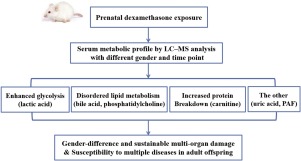当前位置:
X-MOL 学术
›
Toxicol. Lett.
›
论文详情
Our official English website, www.x-mol.net, welcomes your feedback! (Note: you will need to create a separate account there.)
Prenatal dexamethasone exposure-induced a gender-difference and sustainable multi-organ damage in offspring rats via serum metabolic profile analysis
Toxicology Letters ( IF 3.5 ) Pub Date : 2019-11-01 , DOI: 10.1016/j.toxlet.2019.09.007 Guanghui Chen , Hao Xiao , Jinzhi Zhang , Huizhen Zhang , Bin Li , Tao Jiang , Yajie Wen , Yimin Jiang , Kaili Fu , Dan Xu , Yu Guo , Ying Ao , Huichang Bi , Hui Wang
Toxicology Letters ( IF 3.5 ) Pub Date : 2019-11-01 , DOI: 10.1016/j.toxlet.2019.09.007 Guanghui Chen , Hao Xiao , Jinzhi Zhang , Huizhen Zhang , Bin Li , Tao Jiang , Yajie Wen , Yimin Jiang , Kaili Fu , Dan Xu , Yu Guo , Ying Ao , Huichang Bi , Hui Wang

|
Prenatal dexamethasone exposure (PDE) induces developmental toxicities of multiple organs in offspring, but its serum metabolic profile changes before and after birth are unclear. Here, we employed a LC-MS-based metabolomic approach to detect serum metabolites of PDE offspring rats in utero and adulthood, and explore its change characteristics and toxicological significances. Meanwhile, the bodyweight, serum index related to hepatic and renal function were detected. As compared to healthy control rats, PDE reduced offspring birthweight but caused postnatal catch-up growth accompanied by adult liver and kidney function injury. In utero, the differential metabolites in response to PDE were mainly manifested as enhanced glycolysis, increased protein breakdown and disordered lipid metabolism, and multiple metabolic pathways were changed, which displayed gender differences. In adulthood, PDE offspring showed fewer and inconsistent types of differential metabolites compared to those in utero, which exhibited significant gender differences. The main differential metabolites induced by PDE included lactic acid, carnitine, cortexolone, bile acid, phosphatidylcholine, uric acid and platelet activating factor, which may participate in dexamethasone multi-organ toxicities and multi-disease susceptibility. In conclusion, PDE could induce a gender-difference and sustainable multi-organ damage in the offspring rats via serum metabolic profile analysis, which will enhance offspring susceptibility to multiple adult diseases.
中文翻译:

通过血清代谢谱分析产前地塞米松暴露诱导后代大鼠的性别差异和可持续的多器官损伤
产前地塞米松暴露(PDE)诱导后代多个器官的发育毒性,但其出生前后血清代谢谱的变化尚不清楚。在这里,我们采用基于 LC-MS 的代谢组学方法检测子宫和成年 PDE 后代大鼠的血清代谢物,并探讨其变化特征和毒理学意义。同时检测体重、与肝肾功能相关的血清指标。与健康对照大鼠相比,PDE 降低了后代的出生体重,但导致出生后追赶性生长并伴有成年肝肾功能损伤。在子宫内,响应PDE的差异代谢物主要表现为糖酵解增强、蛋白质分解增加和脂质代谢紊乱,多种代谢途径发生改变,这显示了性别差异。在成年期,与子宫内的相比,PDE 后代表现出更少且不一致的差异代谢物类型,这表现出显着的性别差异。PDE诱导的主要差异代谢物包括乳酸、肉碱、皮质醇、胆汁酸、磷脂酰胆碱、尿酸和血小板活化因子,可能参与地塞米松多器官毒性和多病易感性。总之,PDE可以通过血清代谢谱分析在后代大鼠中诱导性别差异和可持续的多器官损伤,这将增加后代对多种成人疾病的易感性。表现出显着的性别差异。PDE诱导的主要差异代谢物包括乳酸、肉碱、皮质醇、胆汁酸、磷脂酰胆碱、尿酸和血小板活化因子,可能参与地塞米松多器官毒性和多病易感性。总之,PDE可以通过血清代谢谱分析在后代大鼠中诱导性别差异和可持续的多器官损伤,这将增加后代对多种成人疾病的易感性。表现出显着的性别差异。PDE诱导的主要差异代谢物包括乳酸、肉碱、皮质醇、胆汁酸、磷脂酰胆碱、尿酸和血小板活化因子,可能参与地塞米松多器官毒性和多病易感性。总之,PDE可以通过血清代谢谱分析在后代大鼠中诱导性别差异和可持续的多器官损伤,这将增加后代对多种成人疾病的易感性。
更新日期:2019-11-01
中文翻译:

通过血清代谢谱分析产前地塞米松暴露诱导后代大鼠的性别差异和可持续的多器官损伤
产前地塞米松暴露(PDE)诱导后代多个器官的发育毒性,但其出生前后血清代谢谱的变化尚不清楚。在这里,我们采用基于 LC-MS 的代谢组学方法检测子宫和成年 PDE 后代大鼠的血清代谢物,并探讨其变化特征和毒理学意义。同时检测体重、与肝肾功能相关的血清指标。与健康对照大鼠相比,PDE 降低了后代的出生体重,但导致出生后追赶性生长并伴有成年肝肾功能损伤。在子宫内,响应PDE的差异代谢物主要表现为糖酵解增强、蛋白质分解增加和脂质代谢紊乱,多种代谢途径发生改变,这显示了性别差异。在成年期,与子宫内的相比,PDE 后代表现出更少且不一致的差异代谢物类型,这表现出显着的性别差异。PDE诱导的主要差异代谢物包括乳酸、肉碱、皮质醇、胆汁酸、磷脂酰胆碱、尿酸和血小板活化因子,可能参与地塞米松多器官毒性和多病易感性。总之,PDE可以通过血清代谢谱分析在后代大鼠中诱导性别差异和可持续的多器官损伤,这将增加后代对多种成人疾病的易感性。表现出显着的性别差异。PDE诱导的主要差异代谢物包括乳酸、肉碱、皮质醇、胆汁酸、磷脂酰胆碱、尿酸和血小板活化因子,可能参与地塞米松多器官毒性和多病易感性。总之,PDE可以通过血清代谢谱分析在后代大鼠中诱导性别差异和可持续的多器官损伤,这将增加后代对多种成人疾病的易感性。表现出显着的性别差异。PDE诱导的主要差异代谢物包括乳酸、肉碱、皮质醇、胆汁酸、磷脂酰胆碱、尿酸和血小板活化因子,可能参与地塞米松多器官毒性和多病易感性。总之,PDE可以通过血清代谢谱分析在后代大鼠中诱导性别差异和可持续的多器官损伤,这将增加后代对多种成人疾病的易感性。



























 京公网安备 11010802027423号
京公网安备 11010802027423号